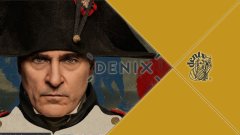HISTORICAL CONQUERORS: 'Napoleon', brings the story of the great emperor to the big screen

'Napoleon', brings the story of the great emperor to the big screen
On the vast canvas of history, few names shine with the magnitude of Napoleon Bonaparte, a titan whose footprints transformed the course of Europe. Now, under the direction of Ridley Scott and the performance of Joaquin Phoenix, the iconic figure of Napoleon comes to life on the big screen in a way never seen before. This cinematographic work invites us to explore the military exploits of a brilliant strategist, the tactics that shook countries and the weapons that forged his legend on the battlefields.
From bold campaigns to ingenious strategies, the film promises to immerse us in the tumult of the Napoleonic Wars, revealing the complexity of a leader who left an indelible mark on history. However, as with every story that travels from the past to the big screen, the line between historical reality and fiction is blurred. In this cinematic journey, witnessing the epic of Napoleon, we will explore the fascinating intersection between historical authenticity and cinematic creativity. In the dance of the real and the imaginary, the true essence of a man who challenged the limits of power and greatness emerges.
From the military tactics that reverberate through history to the intrigues of his personal life, the film unravels myths and reveals truths. The coronation, symbolized by the brush of Jacques-Louis David, captures Napoleon's grandeur, although the reality may have been even more fearless. The relationship with Josefina, far from cliché, reveals a tumultuous connection that defies the expectations of the time.
As the film portrays iconic moments, such as the execution of Marie Antoinette and the shooting in front of the pyramids, we delve into the complexity of a man who, beyond the screen, remains as enigmatic as his own exploits. In this cinematographic journey, we are faced with truth and fiction intertwined, a fact that disappoints many historians and fans of the Napoleonic Wars since it is highly proven that Ridley Scott It does not collect the past, but is based on stories and images that have represented Napoleon since his death, many of them created by his own hands.The Conversation
Now, we could consider Napoleon's film as a faithful portrait of the weapons used and their functionality in each battle and each frame, leaving fascinating scenes where muskets, rifles and cannons are the true protagonists of the scene.
In DENIX We don't just make replicas of weapons; We tell the story behind each of them.
Rifle with bayonet
The rifle with bayonet required manual reloading of its ammunition after each shot. Despite having greater accuracy and effective range compared to pistols, the bullet's trajectory was imprecise and, in the midst of combat, it was difficult to make accurate shots.
Flintlock rifle
The Flintlock rifle was similar to other rifles, since it had a flint or flint stone. When the hammer was actuated, it generated the spark that ignited the gunpowder. The ammunition, inserted through the mouth of the cannon, included gunpowder, a projectile and a wad of paper, used as a plug to keep the previous elements compressed inside the cannon.
Flintlock carbine
Flintlock carbines were equipped with a flint or flint stone. When the hammer was activated, it generated the spark that ignited the gunpowder. These weapons, like other rifles, required manual reloading of their ammunition after each shot. Despite this, they shared the imprecision in the bullet's trajectory.
Cavalry pistol
The cavalry pistol played a crucial role as a self-defence weapon until the mid-19th century. With limited effective range, they were often used as a complement to a sword or knife. Its design allowed a single shot, since the reloading process was notoriously slow and the time necessary to carry it out was rarely available.
2 barrel gun
The double-barrelled pistol was manufactured in St. Etienne by Nicolas - Noël Boutet in 1806, under the direct order of Emperor Napoleon, and displays his insignia on the handle. Napoleon used it as a travel pistol, and its double-barrelled design gave it an obvious advantage over its opponents, thanks to the faster reloading process compared to other flintlock pistols of the time.
Sand Lighter
The Sand Lighter s a single-edged sword with a distinctive curvature designed for cutting, and was commonly used by cavalry, as well as infantry and marine officers during the Napoleonic era. Its conception arises from the need for agility in combat, allowing cutting without the blade of the weapon becoming embedded in the opponent's body, thanks to the curvature of its edge.
Letter opener REPLICA DENIX
Napoleonic cannon
In 1776, Jean-Baptiste Vaquette de Gribeauval, a noted mathematician, engineer, and artilleryman, won approval for his reform of the French artillery. This transformation consolidated the cannon as the fundamental and decisive weapon in the armies' campaigns during the Revolution and the era of Napoleon Bonaparte.
Although the depiction of historical events may vary, the weapons used in the Napoleonic Wars have left an indelible mark on military history.
In DENIX, we offer authentic replicas of the weapons that starred in the most epic of Emperor Bonaparte and his army.
Visit our CATALOG and carry with you a piece of history, where steel and gunpowder meet contemporary craftsmanship.
Discover history through the weapons that forged empires, and revolutionize your collection with pieces that narrate their own epic!










